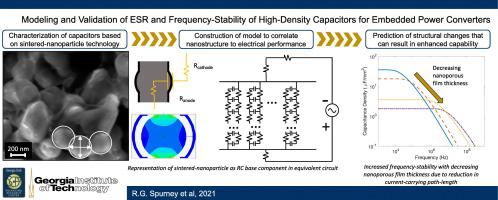Microelectronic Engineering ( IF 2.6 ) Pub Date : 2021-06-27 , DOI: 10.1016/j.mee.2021.111593 R.G. Spurney , H. Sharma , M.R. Pulugurtha , R. Tummala , N. Lollis , M. Weaver , S. Gandhi , M. Romig , H. Brumm

|
Increasingly dense microprocessors will require high-density passive components that can enable integrated power delivery with larger conversion ratios and higher output currents. Of these, nanoparticle-based tantalum capacitors can provide some of the highest volumetric densities compared to other capacitor technologies, due to the high surface area-to-volume ratio. Additionally, their temperature-stable dielectric can handle higher current ratings. However, the complex nanoparticle-based electrode structure results in long conduction paths, resulting in higher ESR and reduced frequency stability. A model is needed that can accurately predict the relationship between capacitor nanostructure and electrical performance so that the nanostructure can be optimized to meet the theoretical limits of device performance. This paper develops such a model, and demonstrates its accuracy by characterizing a real tantalum capacitor device. The model is then used to study the effect of capacitor materials and device geometry on the device performance, including capacitance density, frequency stability, and ESR.
中文翻译:

用于嵌入式电源转换器的高密度纳米结构电容器的 ESR 和频率稳定性的建模和验证
越来越密集的微处理器将需要高密度无源元件,以实现具有更大转换比和更高输出电流的集成电力传输。其中,与其他电容器技术相比,基于纳米颗粒的钽电容器可以提供一些最高的体积密度,因为它具有较高的表面积与体积比。此外,它们的温度稳定电介质可以处理更高的额定电流。然而,复杂的基于纳米粒子的电极结构导致传导路径长,导致更高的 ESR 和降低的频率稳定性。需要一种能够准确预测电容器纳米结构与电性能之间关系的模型,以便优化纳米结构以满足器件性能的理论极限。本文开发了这样一个模型,并通过表征真正的钽电容器设备来证明其准确性。然后使用该模型研究电容器材料和器件几何形状对器件性能的影响,包括电容密度、频率稳定性和 ESR。











































 京公网安备 11010802027423号
京公网安备 11010802027423号